Bio-Invaders: A Janitor Fish's True Story
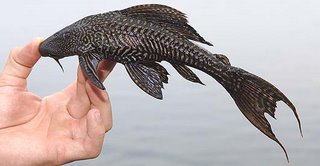
In conservation biology, saving endangered species has been a foremost concern in order to protect the balance of nature. Until recently, that is...
Last week, after typhoon Glenda has wreaked havoc in Metro Manila and other nearby provinces, I attended a conference-workshop that put forth an emerging issue in terms of biodiversity (i.e., variety of life forms) --
INVASIVE ALIEN SPECIES! I know, it sounds out of this world...
IAS, or invasive alien species are described as non-native organisms introduced in an area that may cause or potentially cause economic, ecological, and/or environmental loss. The janitor fish, or the South American sucker mouth catfish (haha, I had to include this interesting detail!) is an example.
Originally introduced by the aquarium trade industry, it may have escaped into natural waters and has now become invasive in the Marikina River. There have been claims that the nuisance catfish has caused damage to the banks of the Marikina River and fish cages in Laguna de Bay. Apparently, these fish burrow into river mudbanks when breeding, and may likely compromise the integrity of riverbanks. Not to mention that the janitor fish has no natural predators and its meat, too rubbery to be taken as fish meal. There have been reports (mostly undocumented) too, of janitor fish sightings from our nearby creek (along AKIC, draining into Pasig River) -- Estero Tripa de Galina to as far as the Agusan Marsh in Mindanao.
So what now? As more and more people get interested in caring for "exotic" species as pets or ornaments, it is important to carefully consider the kind of species that are being "introduced" and brought into the country. I am more concerned with the growing number of aquarium hobbyists, since fish and other aquatic animals are more likely to become invasive due to their motile nature, as opposed to plants.
As expressed by one of the conference's speakers, "To be informed is to be forewarned and forearmed." I guess it would not hurt to learn about these things and share the information with everyone we know...
SDA, SDEAS, SMS Honors' Convocation
Just this afternoon, SDA, SDEAS, and SMS-CDA went on full force in the production of this year's Honors' Convocation.
SDA dominated much of the production, but SDEAS and SMS also contributed to the special numbers. I am pretty sure all of them are just so happy that everything went as smoothly as planned. The afternoon saw how the unique talent of one program complemented the others, making the whole production come alive from the contributions of the Schools. Everyone was beaming with pride as the activity came to an end. (We'll post the pictures by next week)
And, as I shared in the Opening Remarks, the program was not only meant to recognize the students' hard work in the previous school year, but it was also to congratulate their parents for choosing this instution to partner with them in realizing their son/daughter's potentials.
So, congratulations to all! 'Til next school year's Honors' Convocation...
Looking Down from Space
No classes today. Supposedly because of a typhoon. Not the SONA, mind you, but typhoon Glenda, which is supposed to dump heavy rains on us. But Glenda must have looked down favorably on us because not much rain came. With the unexpected free time at my disposal, I got to find out what the clouds see when they "look down" in the area where I live. I mean I got to use Google Earth and tracked our house, flying from space to our neighborhood. Here's our house amidst the open spaces and structures of Bayan Luma, Imus, Cavite (click on the image for a larger view).
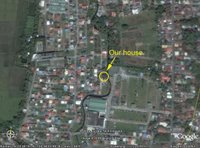
Zooming in, I got to see my immediate neighborhood, our house, and even the mango tree in the backyard. Of course, it helps that you have a sense of where things are. The view from the top is quite different from what we see on the ground.
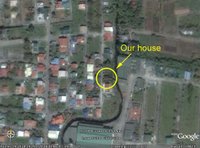
Racing towards Manila, I got to locate our place of work and made out the location of our three campuses.
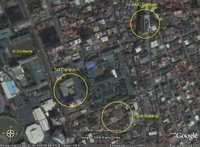
These vistas reminded me of the first time I got to ride an airplane. Seeing the view from the airplane window, I got teary-eyed after having been reminded how insignificant we humans are amidst everything on the ground. And rather than being liberating, the experience guaranteed that my feet will always be planted firmly on the ground.
Google Earth is a free software which combines satellite imagery, maps and the power of Google Search to put the world's geographic information at your fingertips. It works on Windows and Linux, but you need a broadband connection and a 3D-capable graphics card to run it.
This application could be very useful in certain subjects like BIBSTUD (hovering over Israel and Egypt), HISTORY (visiting historical places), TOURISM (looking down on tourist spots), etc.
Ice Cream-Making Competition
Speaking of YHE, I was there at the AKIC Campus yesterday as a member of a 3-man panel of judges for the ice cream-making competition. After a short opening ceremony, the ice cream tasting began. We did not, however, rate the entries on taste alone but also on originality of concept, creativity, presentation impact and neatness. In fact, taste accounts for only 30% of the criteria. And mind you, all 10 entries were created from scratch. Looking at the finished products, you will really marvel at what our students can do.


The first one caught my fancy. It is called
Human Torch Chocolate Peanut (click on it to see a larger version).
Aside from our students, I also noticed parents and a delegation of PNU students, brought there by a PNU teacher who is teaching part-time with us. Chef Peachy and Chef Shirley are the teachers in charge of the activity.
Here are two other entries:

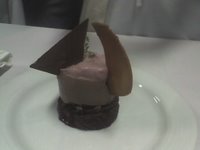
Feel like buying ice cream?
YHE Flairtending Heats Up!
Many tertiary schools with hotel and restaurant management programs in the country have a lot to showcase. One of these is their bar management course where students enjoy flairtending. Looking around to see who's hot, DLS-CSB SHRIM, on its Young Hoteliers' Expo, has extended invitations to HRM schools to participate in the Flair Factor Individual Competition which was held on July 19 at the Multi-purpose Hall.
Schools that participated were University of Santo Tomas, San Sebastian College Recoletos, Holy Angel University, Arellano University, and Our Lady of Fatima University. Each participant was given 7 minutes to show his/her flairtending skills.
You should have seen how participants awed the audience with their nail-biting show of throwing and mixing skills. The audience was likewise entertained by our very own champions, Raminad Ong, (Champion, TGI Friday's First Flairtending Contest) and Mathew Burgos (Grand Champion, Del Monte Flairtending Competition). In the end, the following were adjudged winners:
- First Place - Arellano University
- Second Place - Holy Angel University
- Third Place - San Sebastian College
Indeed, the students left lingering impressions of taste and entertainment, close to their professional counterparts.
Is DLS-CSB a “Living” Academic Organization?
According to a famous study conducted by Shell, many companies of Fortune 500 fame live only to an average life of 40 to 50 years. The topic of organizational longevity is an interesting one. What causes organizational failure and demise? This has been the subject of many studies and researches. For instance, Danny Miller in his book
Icarus Paradox (1990) used the Greek mythology figure to analyze organizational failure. Icarus made himself a pair of wings to escape from an island where he was being held as a prisoner. So well did he fly, higher and higher, ever closer to the sun. We know that the heat of the sun melted the wax that held his wings together, and he plunged to his death in the Aegean Sea. The Icarus paradox tells us that the greatest asset, his ability to fly, caused his demise. We can prepare a litany of companies that were very successful before that became dazzled by their successes. These companies have become inner-directed and lost sight of market realities and the fundamental requirements of competitive advantage. Like Icarus, these companies have plunged into bankruptcy and drowned in their own success.
Where will DLS-CSB be 40 or 50 years from now? We fervently hope that it will not suffer the same fate as Icarus.
Arie De Geus, in his book
The Living Company gives a very insightful analysis of why organizations fail. He believes that most companies fail because they focus too narrowly on financial performance. He argues that organizations must not fail to put sufficient attention to themselves as communities of human beings with the potential to learn, adapt, and grow. To De Geus, a living company emphasizes knowledge rather than capital, adaptability rather than core competencies.
Much has been written about the turbulent and chaotic environment organizations are exposed to these days. Changes in the macro environment and demands of the internal environment have made it very difficult for organizations to quickly adapt to these changes. However, living organizations excel in surviving and adapting in a world that they recognize they cannot control. De Geus, in his study, points out that a policy of tolerance enables a company to diversify without courting disaster; by allowing it to engage continually with its environment without damaging its capacity for growth.
There are companies that do pass the century mark. Interestingly, the study concluded that these companies bore striking resemblances to one another, having four essential traits in common:
- Sensitivity to the environment – a company’s ability to learn and adapt;
- Cohesion and identity – a company’s innate ability to build a community and a persona for itself;
- Tolerance and decentralization – a company’s ability to build constructive relationships with other entities, within and outside itself, and a willingness to experiment; and
- Conservative financing – a company’s ability to finance its own growth and evolution effectively by retaining resources that enable flexibility.
De Geus has an apt name for these organizations - “living companies”, as distinguished from “economic companies”. Living companies have an important purpose, which is to fulfill their potential and perpetuate themselves as ongoing communities. Economic companies on the other hand, are in business to produce wealth for a small inner group.
He writes, “A manager of a living company… must let people grow within a community that is held together by clearly stated values. The manager, therefore, must place commitment to people before assets, respect for innovation before devotion to policy, the messiness of learning before orderly procedures, and the perpetuation of community before all other concerns … The feeling of belonging to an organization and identifying with its achievements is often dismissed as soft. But case histories repeatedly show that a sense of community is essential for long-term survival.”
An economic company, whose purpose is to produce wealth for a few people is likened to a static puddle of rainwater, collecting any new drops into its stagnant basin, while a living company is like a river – turbulent and changing but permanent and always ready to aid a species’ learning.
Does DLS-CSB have what it takes to be a living company? Will it still be around after 50 years? A commitment to values, to people, to learning, and to innovation is necessary to be a “living company”. Will our sons and daughters see the College as a living organization? As one aphorism puts it, the goal of becoming a living organization is a journey, not a destination.
Are we on this journey yet?
Bad News, Good News
You are probably aware of what's happening in the Middle East (You're not? Hmmm, it's a small world we are living in so I urge you to read the news). There's an open war between Israel and Hezbollah precipitated by the latter's abduction of two Israeli soldiers and bringing them to Lebanon. Israel is bombing Hezbollah bases in Lebanon and says that they won't stop until the soldiers are released. Hezbollah demands a prisoners swap and started firing their own rockets towards Israel. Iran and Syria are said to be fanning the flames of war by egging on Hezbollah. As of now, no end is in sight.
And there is the tsunami which killed more than 300 (and counting) in Indonesia.
Back here in our country, we have events flowing from Lt. Lawrence San Juan's decision to cooperate with government investigators re Magdalo activities and who harbored them (Bishop Tobias, for example) while they were on the run. Expect a lot more bad news.
Getting tired? Have a taste then of this new website which collates
good news on anything Filipino. The creators say they want to focus on our achievements as a people, not as a propaganda tool but an honest-to-goodness telling of our story as a proud race. There are items on business, sports, places, arts and culture, technology and even showbiz. Bookmark the site and have a daily dose of good, inspirational Pinoy news.
Syllabus Design Training for SMIT EM & HR Faculty
Last Saturday, July 15, two batches of SMIT faculty completed a seminar-workshop on Syllabus Design, facilitated by Mr. Valentin Berdera of SMS. The seminar content adhered to the DLS-CSB syllabus template recommended by the Curriculum Task Force, with emphasis on developing course objectives.
It was an opportune time for the SMIT faculty to learn together as a community-individually reflecting on the courses they teach but collectively driven to improve the contents of their course syllabi. The faculty participants' steady interest, motivation and energy (especially the EM teachers') were a stark contrast to the day's intermittent weather. And that certainly made the day more pleasurable!
The two training sessions were interesting, enriching and to some extent, challenging for the participants and the facilitator (even the organizers :p). We are grateful to Mr. Terence Tiu and Atty. Sonny Reyes for the opportunity to get to know their teachers and become their partners in learning.
We look forward to sharing more learning experiences with you...
We are in #17!
Hi guys.
Has anyone heard of this new survey/index/statistical study made by this new environmental thinktank called NEF? Well, the Philippines landed in the top 20 out of 180 countries in this list that tries to connect quality of life (life expectancy and satisfaction) vis-a-vis the use of natural resources. Anyway here's the site, check it out:
http://www.happyplanetindex.org/why.htmTiny island of Vanuatu ranked as happiest place, Switzerland tops in Europe, Central America has highest average score.
Updated: 10:30 a.m. ET July 12, 2006 SINGAPORE - The tiny nation of Vanuatu, one of the “happy isles of Oceania,” has topped a new index that measures quality of life against environmental impact, with industrial countries, perhaps unsurprisingly, faring badly. The UK-based New Economics Foundation aimed to measure the environmental efficiency of global progress with its “Happy Planet Index” report, which it said painted a different order of world wealth but showed all countries could do better.
“The Happy Planet Index strips the view of the economy back to its absolute basics: what we put in (resources), and what comes out (human lives of different length and happiness),” the NEF said. The Group of Eight, an unofficial forum of the heads of leading industrialized nations meeting on July 15-17, failed to make the top 50. Host Russia came in at 172 in the 178-nation survey, with the United States at 150 and the UK at number 108.
The NEF, an independent group that did the index jointly with UK-based green campaign group Friends of the Earth, said the report showed high levels of resource consumption do not reliably produce high levels of well-being. “The order of nations that emerges may seem counter-intuitive. But this is because policy makers have been led astray by abstract mathematical models of the economy that bear little relation to the real world,” said NEF’s policy director Andrew Simms.
NEF said Central America was the region with the highest average score, combining good life expectancy of 70 years with an ecological footprint below its globally fair share, while island nations scored above average and Switzerland came top in Europe.
Out of Asian nations Vietnam came highest at number 12 and Singapore was ranked lowest at 131. African countries made up seven of the bottom 10, with Zimbabwe coming last. Vanuatu is part of a vast sprawling Pacific archipelago described as “the happy isles of Oceania” by author Paul Theroux.
The full Happy Planet Index is available at
http://www.happyplanetindex.org
A New Film Director from MMA!
Hello everyone!
Welcome back! Didn't we all have a nice break? Sana more to come...joke!
Just wanted to share some good news from the SDA front. One of our MMA graduates, Jeff Tan, 24 yo is now a bonafide film director. He is at the helm of the upcoming horror-thriller "White Lady" that's produced by Roselle Monteverde-Teo, daughter of Lily Yu Monteverde aka Mother Lily. What's significant about Jeff's movie is that unlike other young filmmakers today, his' is considered mainstream and not indie, meaning produced (aka financed) by a major film outfit (Regal Films and its subsidiaries), will have strong marketing campaign and thus the potential to reach more people. And based on Ram's and Jag's feedback re the trailer, the movie has good computer graphics (CG) special effects (proof of what we're teaching in the MMA?). I just hope the story will be good too but then again that's the scriptwriter's job.
I'd like to invite everyone in this blog and elsewhere to patronize our graduate's first film.
Also, we're planning to invite him to talk to the SDA students re his experience as a first-time director. I believe it's a rich source of information and insights that he can share with the community.
All for now, till next!
IBM and SMIT-CA Tie-up
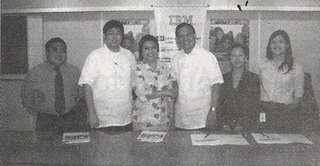
This is a press release that appeared in the Business Mirror (July 11) regarding the DLS-CSB and IBM academic initiative tie-up. The program will be under the jurisdiction of the Computer Applications and Information Management Programs of SMIT headed by Mr. Benhur Ong.
De La Salle-College of Saint Benilde recently partnered with IBM for the implementation of the IBM Academic Initiative Program. This project seeks to partner with institutions of higher learning all over the world to further educate students in new technology, open architecture, and industry-relevant skills. IBM's goal is to address the IT skills shortage in the market, encourage technical innovation among the youth, and to drive open standards.
Colleges and universities involved will incorporate industry-relevant and highly marketable skills into the students' education and stem the shrinking enrolment numbers for IT courses. According to the 2004 Commission of Higher Education statistics, the country produces a considerably large amount of IT graduates every year (10.25% of total graduates) but the numbers have been dropping year to year because of work opportunities for nurses and teachers. New global opportunities in IT are on the rise and the schools in the country are willing to take steps to close the gap.
No Paper Checking: Online Midterms Begin Through Moodle

The possibilities are endless with a checking-free exam facility.Midterms will never be the same as the Center for Learner-Centered Instruction (CLCIR) Instructional Technology Unit completed its pilot run of paperless midterm exams at the E-Classroom and International Center (IC) computer laboratories.
Ms. Marie Ann Gutierrez, a faculty from the School of Multidisciplinary Studies (SMS), collaborated with the Center for Learner-Centered Instruction and Research to conduct the paperless midterm examinations for three History classes with a total of about 112 students. The exam had a total of 43 objective type questions and one essay type item.
A Moodle briefing, technical dry-run, and item type familiarization preceded the online midterm testing. Prior to the CLCIR-supervised pilot run, Ms. Cynthia Amador, Mr. Rogelio de la Cruz, Mr. Antonio Ingles, Mr. Dary Dacanay, and Mr. Frederick Sanchez had conducted paperless, objective type midterm or final exams.
The pilot run came soon after the installation of additional computer hardware to further improve the performance of the DLS-CSB Moodle Learning Management System.
OpenDocument Format
Remember the OpenDocument Format (ODF) I mentioned in my
post on Ubuntu 6.06? Well, here's the latest on that topic.
After earlier rejecting ODF and proposing a competing
Open XML format, Microsoft finally bends to pressure and now
offers software to convert Office documents to ODF. Why? It is mainly because they don't want to be left out. ODF is fast gaining ground, particularly among governments. I have been tracking this for quite some time and see that ODF will eventually get support from
many institutions. Why again? Because we all want to make our documents readily accessible, and for a long time.
Not many realize that in the current setup with Microsoft, we will have to continually pay them for MS Office licenses in order for us to open
our documents created with their software. This is because the format is proprietary. If we create a memo, a syllabus, or an operational plan in MS Word now, how do we open it 10 years from now? Of course, with a
paid copy of MS Office. But if we create documents in open formats, we can open the same documents with other, and possibly free,
applications.
One such application which can open and create ODF files is OpenOffice.org. I have created two reference guides, called Walkthroughs, which can assist prospective users of Writer (a word processing application) and Impress (a presentation application). There are a lot of screenshots and step-by-step instructions on doing the usual tasks.

Both Walkthroughs are available at the CLCIR. Ask for the latest copies.
Graduation Thoughts by a SMIT Faculty Member
I would like to share an editorial, entitled
Thoughts on A Graduation, written by a SMIT-HRM faculty member, Mr. Schubert Ceasar Austero, about the DLS-CSB graduation ceremony held last Saturday.
Mr. Austero handles Organizational Behavior and writes a regular column in the Manila Standard.
Taking to Heart Corporate Social Responsibility
From July 5-7, 2006, the League of Corporate Foundations (LCF) will hold a Corporate Social Responsibility Expo at The Fort. For the last two years, the Office for Academic Programs (OAP) of SDEAS closely collaborated with Deaf and hearing faculty members on the design and maintainance of the LCF and the
CSR Expo website. In exchange for this service, LCF generously assisted SDEAS in our work through various partnership opportunities. Often, these opportunities were for internship and employment needs of our students, as well as advocacy for greater understanding and appreciation of the uniqueness of Deaf people.
This year's expo theme is "
Taking CSR to Heart". You are invited to register online and participate in the
3-day event. The plenary sessions will be held at the Every Nation Leadership Institute building. The exhibits and special workshop sessions will be at the Market! Market! exhibit area. (See
map).
The Office for Partnership and Development (OPD) of SDEAS is the lead office in charge of the exhibit. OPD will also give a lecture presentation on "Deaf Employment as a CSR Activity" and a faculty from the OAP Filipino Sign Language Program will handle the Sign Language interactive session on
July 5. There is also an opportunity for us to do some business at the Trading Post area. So we are bringing along some Deaf students currently undergoing business OJT and some graduates doing business to also participate in the 3-day event.
We would also make sure that marketing collaterals on other degree and non-degree programs will be included in our packet for distribution to LCF member orgs and visitors. Attention MCO. :)
So come and join us!
Salamat!
What's in a Name?
There is a school located in Makati called LaSalle College International. According to Mr. J. Badillo of the the DLSU Marketing Communications Office, they have no proprietary rights to the name of their college in the Philippines because De La Salle Philippines (DLSP) owns the name. We largely ignored them last year but recently, they have been coming out with print advertisements. Their programs are similar to our own except as diplomas. We were told that LaSalle College International is named after a French Canadian explorer and not St. John Baptist De La Salle. This school had a tie up with St. Scholastica's College until recently.
There was a legal battle reported in the newspapers, re right to a name between Shangri-La (Hotel) and a Shangrila (Chinese, locally owned) restaurant located somewhere in West Avenue, Quezon City. Shangrila restaurant was the first company to use said name and then the Hotel followed after some years. The restaurant sued the Hotel. Word has it that the restaurant won the right to the name and so you have Edsa Shangri-La, Makati Shangri-La, and Shangri-La Mactan Island Resort.
DLSP owns the right to the names La Salle and De La Salle here in the Philippines. However, should we want to consider taking action, it is not only for DLS-CSB to act on. It is the DLSP who will have to handle it.
While some of us may feel threatened by their promotions, it is essential that we continue to do what we do best, which is teaching minds, touching hearts and transforming lives. No ad can ever beat this because we LIVE it!
Point Persons Identified
In May,
we asked schools to identify point persons for four important school committees --
Curriculum Development,
Faculty Development,
Research and
Marketing.
Here are the faculty members identified by the schools/offices:
Curriculum Development -- Mitali Goswami (SDA), John Xandre Baliza (SDEAS), Lucy Bustamante (SHRIM), Rogelio del Cano (SMIT), Jose Alain Austria (SMS), Mona Lisa Menguito (SPaCE), Ma. Teresa Jose (OSA), Marissa Rodriguez (CLCIR)
Faculty Development -- Jose Antonio Garcia (SDA), Joy Cristal (SDEAS), Gil Acuna (SHRIM), Cecilia Poblete (SMIT), Dr. George Lu (SMS), Mona Lisa Menguito (SPaCE), Socorro Bacay (OSA), Rodel Bugarin (CLCIR)
Research -- Robin Serrano (SDA), Maria Veronica Perez (SDEAS), Ramon Siocon (SHRIM), Dr. Evelyn Belleza (SMIT), Valentin Berdera (SMS), Paulino Villanueva (OSA)
Marketing -- Marie Virginia Alfon (SDA), Noemi Lacambacal (SDEAS), Angelo Lacson (SHRIM), David Terence Tiu (SMIT), George Binay (SMS), Randy Torrecampo (OSA)
Let us give to them our usual support, feedback, and suggestions.
DLS-CSB Regional Testing Centers
It's final! Here's the list of our regional testing centers for SY2007-2008 intake. If you have contacts from these provinces who wish to apply, please inform them of our testing centers.
Iligan/Cagayan de Oro: La Salle Academy
Davao: Davao Psychological Services and Research Center
Cebu: Sacred Heart School
Bacolod: University of Saint La Salle
For application, testing dates and contacts, visit the
DLS-CSB Admissions website.











